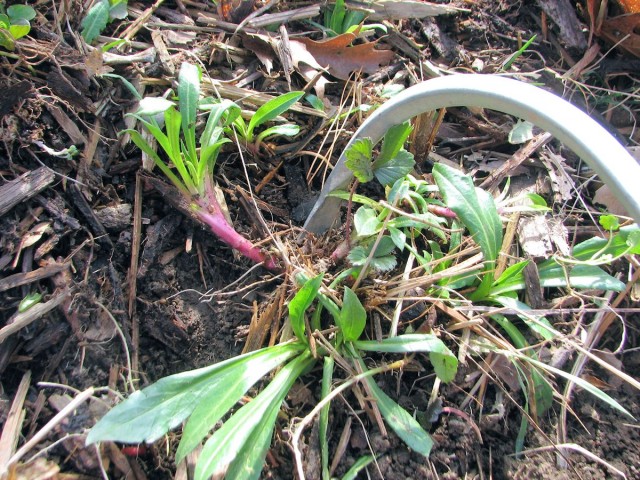As I’ve mentioned already, I’m perpetually behind on my weeding. Really behind. I decided I’d share my techniques with all of you, in case you find yourself up against a flower bed that’s really been let go too long.
Make it easy on yourself.
Make sure the bed is moist, either from recent rainfall or from supplemental irrigation. Set aside a couple of hours so you can go at a relaxed pace, and avoid the hottest part of the day. If the location is in shade for part of the day, try to weed then. It will be easier on you and the plants.
Equip yourself properly.
You’ll be going after some really big weeds, and a little hand cultivator just won’t cut it. Make sure you have a garden fork and a serious trowel, as well as leather gloves for the prickly weeds. Slather yourself with sunblock, wear a hat, and bring a drink.
Pace the work.
Be realistic. You’re probably not going to get it all done in one day, but you want it to look better than when you started, right? This is where the triage comes in. Take it from me, it is better to go after one particular weed, or one type of weed, throughout the whole bed, than it is to focus on one square foot and get every single weed.
Scan the bed. Which weeds are already past blooming, and are going to seed? Get them first. If it’s true that “one year’s seeding yields seven years’ weeding,” I figure I’ve got at least 49 years of weeding left. Oh, well. Let’s see if you can do better than me. Push that garden fork straight down at the base of the weed, and pry it up. Now get down there and grab it below the crown, and see if you can get all of it.
You have to use your judgment here. If you’ve got a humongous dandelion growing up through the middle of your prize whatever, this may not be the time to get the root. Wait for spring or fall, when you can lift the plant and the dandelion at the same time, and reset the plant after the dandelion has been thoroughly evicted. For now, just pull off all the dandelion blossoms and seedheads.
After you’ve gotten all the seeders, go after the big weeds that are currently blooming. “Big” is the key concept here. You will be amazed at how much better your bed will look after all the space hogs are gone. Now go after the things trying to set up permanent residence, such as: tree and shrub seedlings (save if you want to plant them somewhere else), brambles, poison ivy, and anything else you know to be really invasive.
Now that you’ve done all that, stand back and take a look. It does look better, doesn’t it? But it’s not done by a long shot, right? Well, look at your watch, you just might have to call it quits for the day. And even if you’ve got more time, your body may have had enough. At the very least, it’s time for a major break. Get a drink, stretch, and rake up and haul away everything you’ve yanked so far. You might consider watering any plant that had to be seriously disturbed, especially if rain isn’t in the forecast.
There are several ways you can go from here, and you might decide on a combination approach:
- Get an edge. If you’ve got permanent edging, trim the grass close to it, and make sure no grass or other weed is jumping over into your flower bed. If you use a spade to maintain the separation of lawn and garden, recut it so it looks sharp and crisp. This does wonders for giving your garden that tended look.
- Search and rescue. Do you have a precious something about to be overrun? Or perhaps a star performer is about to come into bloom? Remove all the weeds around any plants whose well-being is of particular concern to you.
- Micromanage. Mentally divide the bed into sections, and weed each section thoroughly. It still helps to pull the biggest weeds first. I try to get all the taprooted weeds first, because I have to stand up and use the fork with them. After they’re all gone, I can settle down to weeding at ground level with my hands and a trowel or hand fork, sitting, squatting, or kneeling as the situation requires.
If you’re like me, you may never get past the triage point with a particular bed, either because the rest of your life interrupts again or you discover yet another bed that needs rescuing. But if you do manage to get through all of the above steps, all that remains is “neatening up.” Deadhead, trim back, stake, prune–you know, what is usually thought of as garden maintenance. Give yourself a pat on the back, or maybe throw an impromptu party. And then–MULCH!





Recent Comments